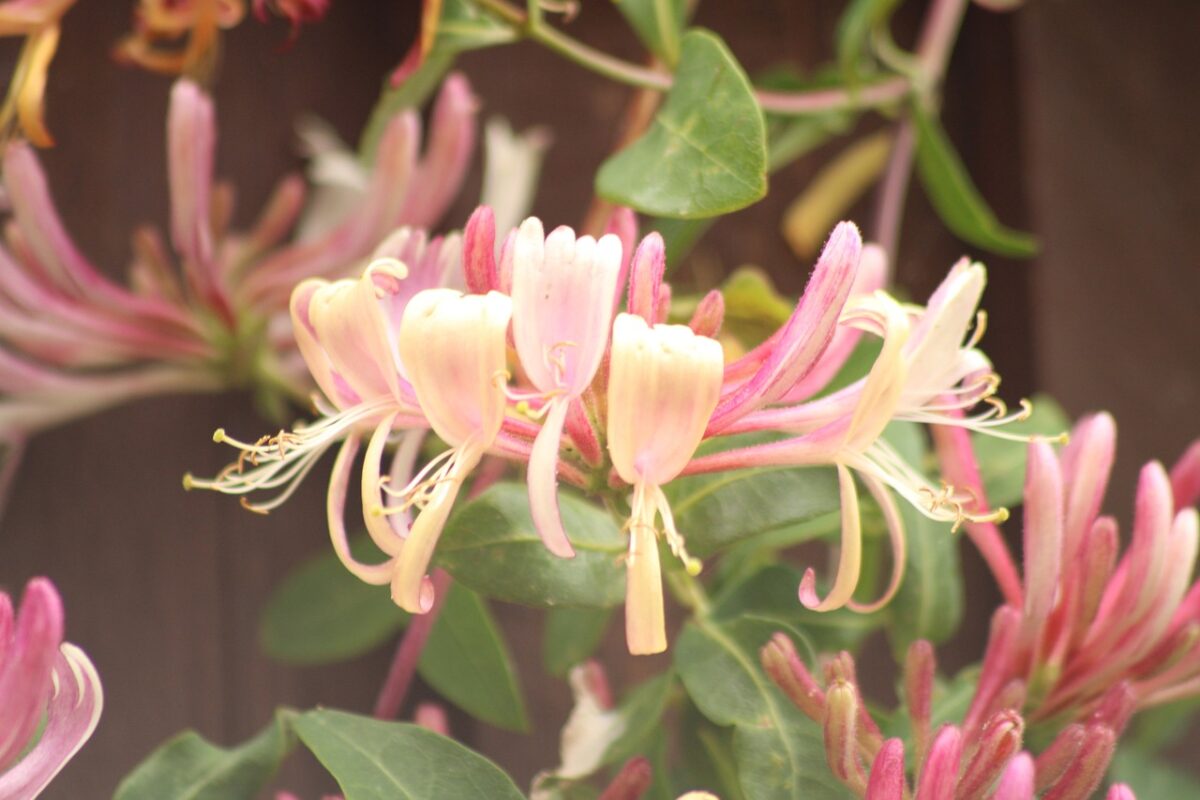IDENTIFICATION
Scientific name:
Lonicera caprifolium
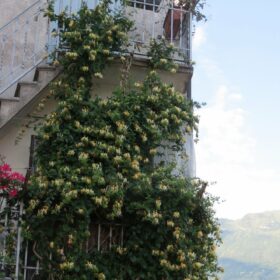
Italian common name:
Common Caprifoglio or Madreselva. Other common names are: Abbracciabosco, Vincibosco, Succiamiele, Legabosco, Uva di San Giovanni, Manicciola e Manine.
Family:
Caprifoliaceae
Origin:
Native to Europe, Asia and northern Africa, it is one of the most widespread species of Lonicera. The genus, in fact, includes around 200 species, of which around ten belong to the Italian spontaneous flora. The common honeysuckle is considered a species native to Italy.
Environment:
it is found in the wild places of the coastal and sub-mountain regions, in deciduous woods that are not too sunny. It can easily form natural hedges in association with chestnut or turkey oak; sometimes, however, due to its fickle habit, dense cobwebs are created which ultimately suffocate the other plants. Altitudinal spread: from the plain up to 1200 m above sea level.
Evergreen or deciduous:
evergreen
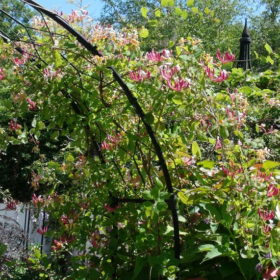
Toxicity:
The berries contain a toxic, bitter glycoside called xylosteine that causes poisoning with nausea and diarrhea
PLANT RECOGNITION
Height:
6 – 7 meters
Width (extension):
the width of a vine depends on how the branches are fixed. However, it can be said that the production of foliage is important, the growth is rapid and the plant is vigorous, therefore it creates large, somewhat messy masses if not properly fixed.
Habit:
The plant is of the lianosa type (with the shape or structure of a vine). The biological form of this species is defined as liana phanerophyte: they are generally woody plants but incapable of standing on their own and therefore have a climbing habit. This type of vine twines around the supports.
Leaf: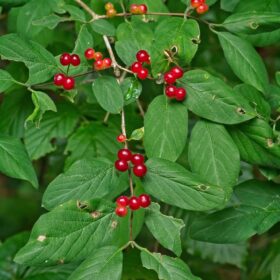
The leaves are simple with entire margins without stipules along the stem and are arranged in opposite ways. The lamina is firm without being leathery; the upper page is light green, almost brilliant, while the lower one is darker with glaucous reflections. In some cases, the phenomenon of heterophylly (presence of differently shaped leaves) can occur, especially with the leaves of the terminal shoots. The prevailing shape is ovate-elliptical.
Flower:
The inflorescence is made up of sessile flowers (about 6 specimens) arranged in bundles inserted in the center of the last pair of leaves grown in elliptical and cup-shaped plates. The shape of the flower is of the “labiata” type and variously colored especially red and white.
Flowering:
from May to July
Fruit:
The fruit is an inedible as it is toxic berry of about 8 millimetres, fleshy and oval in colour, depending on the variety, orange-red containing some discoid seeds.
Stem:
climbing and twining (they wrap around other trees or shrubs), they can reach up to 5 meters in extension and in the initial phase of development they are very branchy. The almost tufted branching is given by the presence of multiple, supernumerary and serially overlapping buds in the axillary areas of the stem.
The appearance of the stem is that of a bark which, as it ages, takes on a brown-greenish colour. Young stems show some pubescence.
Another peculiarity of the stem is that it is characterized by the formation of a single layer of “thickened membrane” fibers which enter into the constitution of the “book” inside the bark, for each annual vegetative cycle, thus facilitating the determination of its age.
Property: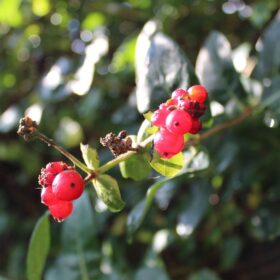
Used for centuries as a natural remedy to treat a variety of ailments. The plant contains nutrients such as flavonoids, anthocyanins, organic acids, tannins, sugars, vitamins and minerals. These compounds have been shown to have antioxidant, anti-inflammatory, antimicrobial, antispasmodic and diuretic properties.
It can be used to relieve the symptoms of respiratory diseases such as asthma, bronchitis and flu, digestive disorders such as diarrhoea, nausea and vomiting or to treat insomnia, anxiety and depression.
It can be taken in the form of herbal tea, decoction or extract. It can also be applied directly to the skin to treat skin infections, wounds and burns. It is advisable to consult a doctor before taking any remedy based on Lonicera caprifolium.
Parfume: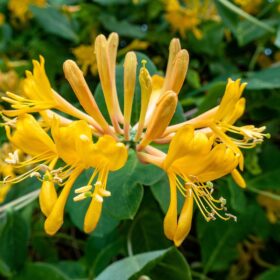
intense
NEED
Maintenance:
medium
Light Exposure:
it prefers partial shade positions although, being a resistant plant, it can also tolerate intense heat and cold up to -15°.
Soil type:
it adapts to rocky soils, but obviously prefers fertile and well-drained soils.
Soil acidity:
pH between 6,8 e 7,2
Italian climatic area:
In Italy it is a common plant only in the peninsula (the islands are excluded).
Need for water:
If you purchase a common honeysuckle, the water needs of the adult plant are low except in cases of intense heat and dry soil. If you take rarer cultivated varieties they may be less resistant and more in need of watering. They still need good watering during the growing season.
Propagation:
It is sown in autumn immediately after harvesting the fruits, or in spring after 2-3 months of stratification. Much simpler is reproduction by offshoot buried in late spring and grown during the following autumn, or by separation of the tuft.
Illnesses:
generally resistant to pests and diseases, but can be subject to problems such as rust, gray mold and scale insects.
Pruning:
More than anything it is a problem of order. The plant is, by its nature, rustic and vigorous. It is a plant that continually throws out lateral shoots which must be tidy if you don’t want the foliage and the entire final effect to be confused and messy. it must be pruned regularly to maintain the desired shape and size. Flowering on the previous year’s branches, pruning should be done at the end of autumn after flowering.
PARTICULARITY 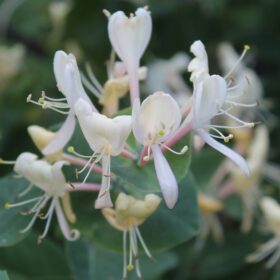
The term of the genus (Lonicera) was coined by Linnaeus in 1753 by adapting the surname “Lonitzer” to the Latin, wanting to remember the botanist Adam Lonitzer (1528-1586) – in Italian this surname is pronounced Adamo Lonicer – a doctor trained in Frankfurt.
The specific epithet (caprifolium) derives from Latin and is composed of two terms: “goat” (capra) and “folium” (goat and leaf). This term probably derives from the fact that goats graze on the leaves of this plant.
“Honeysuckle” is the common name of some species of the genus “Lonicera”, but it is also the vulgar Italian version of the name of the genus, so misunderstandings often arise which can however be easily dispelled by always adding the scientific name.
The common name of “Abbracciabosco (Embrace forest)” derives from its climbing habit which often wraps around, damaging the host plant. For example, the Greeks called these plants “peryclimenon” (which loosely translated means “encirclement”).
Annotations
It is a plant visited by bees for pollen and nectar. These flowers especially attract large hymenopterans (such as bumblebees) and butterflies of the Sphingidae family, which with their long proboscis (called “spiritromba”) are able to collect the nectar contained, up to half the height, in the long corolla tube.
Tradition has it that flowers, placed in a girl’s room, would favor dreams of love, just as, kept in the homes of unmarried girls, they would favor marriage.
If you want to learn more about other interesting amenities we recommend this article by Angela Borghesi on Doppiozero
In the kitchen:
It is used to prepare a tea-type infusion from the leaves.
THE MONDO DEL GIARDINO ADVICE
Shakespeare quotes it in “A Midsummer Night’s Dream” […so sweetly does the honeysuckle intertwine with the sweet convolvulus…] and Emily Bronte in “Wuthering Heights” […It was not the bramble that bent towards the honeysuckle, but the honeysuckle that embrace the bramble…]. In Tristan and Isolde, Tristan entrusts his message to the honeysuckle, entwined with the hazelnut: “Together they can last for a long time – says Tristan – but if one separates them, then the hazelnut dies immediately and the honeysuckle as well. My beautiful friend, so it is with us: neither you without me, nor I without you.” Will it be worth experiencing its beauty and scent in our garden? It seems so…always.
Now on horseback! Work awaits us! Our new wonderful outdoor space is about to be born!
GOOD WORK and…if you have any questions, write to info@ilmondodelgiardino.com
Image sources: Thanks to Pixabay and many thanks to Lorn Slack for the cover photo. Then in order of insertion,doublezero.it, shoppuntoflora2000.it, Manfred Antranias Zimmer, Shirley Hirst, Cally Lawson, Alexei, Beverly Buckley, Viktoriya2210 Steve Bidmead for the closing photo.


